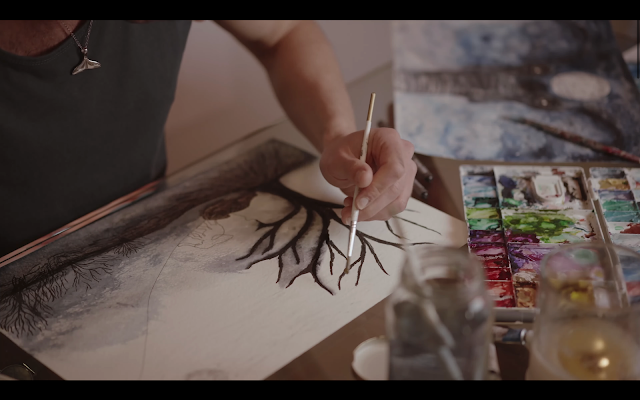Join author illustrator, Ryan Abramowitz as he unpacks the artistic shapes of loss and love through animal allegory with the creating Elegy for an Elephant. We recommend you first read Elizabeth Vercoe's stirring review of this incredible new picture book release.
How does the passing of my father catalyse the migration of an elephant crossing picture book plains?
Views of the world outside windows have always framed elements of authoring and illustrating my debut picture book Elegy for an Elephant (EFAE). I was staring at the sad fog outside the courtyard of my Copenhagen dormitory studying abroad when my sister called to tell me our father had ended his life.
Her
words, like the whiteout outside were heavy and surreal. Seven years later, I
have folded this lived experience into EFAE which is aimed at readers (aged 7+)
navigating grief, and for the families and communities supporting them in their
mourning.
I was staring out the night sky from the airplane windows when I was returning home to my dad's funeral in Sydney. As I was flying parallel to the earth on a horizontal axis, his soul was ascending vertically to heaven and we said our goodbye in the clouds. And during those long nights in lockdown, in the stillness and silence I called out to my dad again. Across the constellations he appeared in elephant form. Since then I started imagining the world through an anthropomorphic lens, and so as flippers fold into feathers EFAE chronicles the journey of a whale and two birds (based on my sisters and I). Perhaps interpreting this life event through animal allegories makes something so heart-achingly devastating, somewhat more digestible. To me, this is also the magic of picture books.
Understanding the sensitivities and triggers of
addressing such subject matter, I felt it was important and responsible to
collaborate with esteemed organisations like Roses in the Ocean and Jesuit
Support after Suicide services, which offer crucial support to those grappling
with suicide loss. Similarly, opening up a dialogue and frequently engaging
with mental health experts, child psychologists, suicide bereavement researchers,
and grief counselors gave me invaluable feedback that ensured the book treads
as gently and delicately as possible. As such EFAE is designed to facilitate safe
discussions surrounding loss.
This made the process of
creating the picture book an even more complex undertaking. In addition to
working with the editor and art director (Margrete Lamond), every third or four
draft of the manuscript was shared with these mental health reviewers to gather
their insights. These were then baked back into the revisions. In tandem, I was
also learning about how to harness the elements of visual neuroscience (such as
voids and masses, horizon lines) to establish narrative mood while working on
the storyboarding of the artwork.
The profound weight of grief that follows a parent's suicide is imbued with unique textures of grief such as abandonment, guilt and confusion. It's not just mourning a loss, but untangling a web of emotions rooted in the circumstances of the death itself. Haunted by the questions of 'Why did they leave?' or 'Could I have done anything differently?' inspired me to consider a plot in which those left behind are given the opportunity to ask the departed soul these burning questions.
As such EFAE prompts
such important conversations between children and caregivers or teachers,
acting as a catalyst for healing discussions. Artistically, these pages show the cycles of the
moon as markers of time, while each child is illuminated by the soul of our
father (whose embrace is expressed as a starry and luminous trunk).
Children
thrust into the realm of suicide loss undergo what's known as ‘traumatic
complex grieving’ and conflicting emotional processes. A blanket stigma often isolates survivors,
inhibiting access to vital support, while there are currently few resources in
the suicide bereavement space. It is
into this literature shortfall that I believe Elegy for an Elephant can make a meaningful
difference. Transparent conversations
about suicide empower children to process their emotions without shouldering
blame. Amidst my own journey of healing, I also realised that embracing the memories
of our lost loved ones allows them to feel present and accessible, even in the void
of their physical absence.
As animals drawn from of the land, sea and sky the characters can be anyone, making EFAE feel timeless and relevant. Through the resounding message that our loved ones live on within us and through our living, I hope that EFAE is a testament to enduring love and a comforting companion in times of sorrow.
It is my wish that this elegy for my
father inspires readers to imagine their own. So that in the stars readers may
also see the loved lost crossing the starry firmament. This can transform pain into empowering a sense of
healing and connection, because grief is love. My wish is that this book helps those in grief
to feel
seen, soothed and supported, reassured that love surrounds us like the ocean, and is forever, like the
stars.
Ryan
Abramowitz is a Melbourne based artist and writer. Learn more about his debut picture book, Elegy for an Elephant online at www.narrativesofnature.com Or follow the artistic journey on Narratives Of Nature's Insta account and
Facebook
Disclaimer:
"Elegy for an Elephant" is a fictional work by Ryan Abramowitz and is
not intended as a substitute for professional mental health advice.
Note: This article is for informational
purposes only and should not be considered as professional advice. For guidance
on supporting children through grief and mental health challenges, consult with
qualified professionals.



